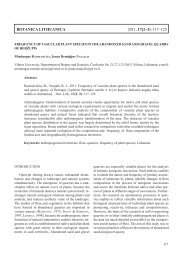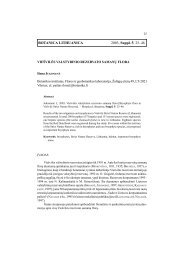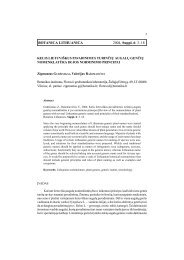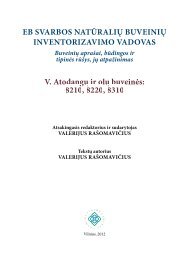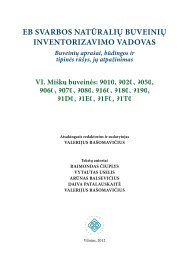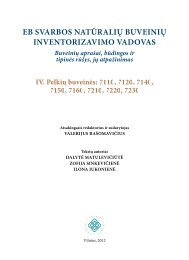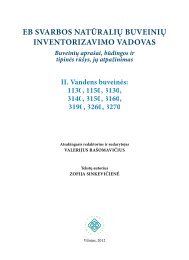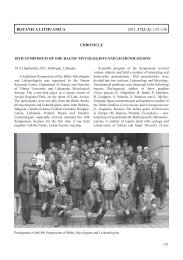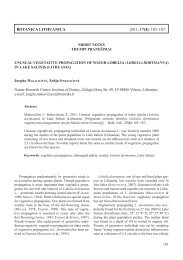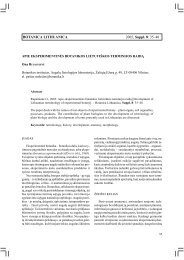FUNGI AND LICHENS IN THE BALTICS AND BEYOND XVIII ...
FUNGI AND LICHENS IN THE BALTICS AND BEYOND XVIII ...
FUNGI AND LICHENS IN THE BALTICS AND BEYOND XVIII ...
Create successful ePaper yourself
Turn your PDF publications into a flip-book with our unique Google optimized e-Paper software.
<strong>FUNGI</strong> <strong>IN</strong> SOIL BELOW CORMORANT (PHALACROCORAX CARBO S<strong>IN</strong>ENSIS)<br />
COLONY <strong>IN</strong> WESTERN LITHUANIA<br />
D. PEČIULYTĖ*, V. DIRG<strong>IN</strong>ČIUTĖ-VOLODKIENĖ<br />
Institute of Botany, Nature Research Centre, Žaliųjų Ežerų Str. 49, LT-08412 Vilnius,<br />
Lithuania<br />
*E-mails: dalia.peciulyte@botanika.lt, vaidiluted@gmail.com<br />
The possible effects of a great cormorant Phalocrocorax carbo colony on abundance,<br />
diversity, and species composition of soil fungi communities were investigated in a<br />
coniferous forest near the Curonian Bay in western Lithuania. Samples were collected at five<br />
study sites that had the same vegetation composition but were in different stages of breeding<br />
colony establishment and a site outside cormorant colony (control). Samples of the soil (0–10<br />
cm) were collected in August 2010 and May 2011. The dilution plating method and several<br />
selective media were used for fungal isolation and identification. In the present study, we did<br />
not find significant correlations between the abundance of soil fungi and intensity of the forest<br />
stand damage by cormorants (i.e. stand intensively colonized by cormorants from 1983 up to<br />
2011, moderately or newly colonized, and control area), but we found fungal species severely<br />
affected by the colonization intensity. Total numbers of cultivable fungi in soil at formerly<br />
colonized and the control sites were higher in spring, while at newly and intensively colonized<br />
sites – in autumn. The lowest fungal abundance was determined in the soil of sites with<br />
maximal vegetation damage and obviously slowed down organic mater destruction. Trends of<br />
the negative correlation between the total number of fungi and total carbon content in these<br />
sites (R=–0.51, p>0.05) also shows the slowed organic matter destruction process in soil.<br />
Fungal abundance negatively correlated with low (~ 3.1–3.8) soil pH and phosphorus content<br />
(R=–0.6537 and 0.6358, p



